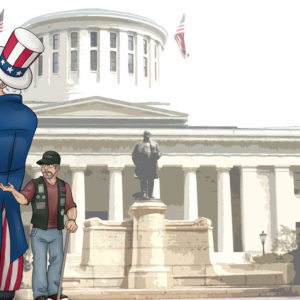
State of the Military Surplus Industry
By: Dr. Frank Arian, a Surplus Today writer
Building and maintaining a stable, profitable Army Navy surplus business is anything but easy. The business my father and I have dedicated our careers to has many of the challenges that other retail businesses face, but also a plethora of challenges that are unique to the surplus business. Owners are faced with difficult decisions on a regular basis. The outcomes of these decisions will result in either profit, loss or no net change.
Making good business decisions that result in a higher likelihood of a profitable outcome are enhanced by several things:
- (a) having an understanding of the business’ origins and what defines that business,
- (b) how and why the business has changed, and
- (c) comprehending the current state of the industry.
Understanding all these issues can help an owner be successful and run a viable, profitable business.
History of Army Navy surplus
It appears the earliest Army Navy surplus stores were started after World War I. Old catalogs, price lists and advertisements seem to indicate that these were hardware stores, dry goods stores and variety stores that received an influx of low-priced soft goods and hardware from the U.S. war effort. With very low wholesale cost, these items were used to attract customers with their low retail price and high quality. The U.S. WWI involvement was short-lived and not of massive scale, however, so surplus was not that abundant and these stores were not widespread. Remarkably, some of these stores survived the 1929 Stock Market crash and the Great Depression.
The Army Navy surplus business, as we know it, came of age following World War II. There were several significant differences between WWI and WWII that helped the business flourish and set the stage for the incredible 50 year run to come. During WWII:
- The length of direct U.S. involvement was considerably longer.
- Overall conscription was much larger.
- The number of “boots on the ground,” which correlates with dry goods production, was greater.
- The war was fought on two major fronts that had considerably different climates and materiel needs.
Perhaps the greatest difference between the two wars was the level of the threat posed by the Axis Powers. Germany had swallowed up almost all of Europe and was advancing and attacking east of its original borders. A unified German continent was at one point a distinct possibility. In the Far East, Japan had nearly consolidated under its control: the entire West Pacific rim and was marching westward. In the end, there could be no acceptable outcome other than total victory. Given the scale of the conflict, level of risk, limited options for an acceptable outcome, and the inestimable length of time of the conflict, production of war materiel went at maximum speed until well into the war. Consequently, an absolutely massive amount of dry goods and hardware came up for sale and disposal at war end. This “surplus” of goods would last some 50 years and served as the foundation for the surplus industry.
Surplus businesses sprang up all over the United States following WWII. After all, how many retail businesses could boast a 500% markup? You could buy something for a penny and sell it for a nickel all day long. Many of the founders’ family fortunes were accumulated during this period.
What defines the surplus industry?
Traditionally speaking, what defines the Army Navy surplus business can be embodied in just a few words.
- Value
- Variety
- Quality workmanship
- Military Theme
- Personalized Service
While this is still the image that most of the public still envisions, it has become increasingly difficult to live up to this reputation created so long ago. The reasons why will become clear momentarily.
How the industry has changed and been affected by these changes
Over the many years since the founders launched their post-war retail businesses, many aspects of the business milieu have changed. Let’s take a tour of the major changes that have occurred in the Army Navy surplus business since WWII and how these changes have helped or hurt the business.
Once the bread and butter of the business, supplies of WWI, WWII and Korean surplus have run out and surplus from the Vietnam war is dwindling. What’s left of these surplus items is now available in limited numbers and have entered the realm of the collecting community. Put simply, older surplus is hard to find and costs big bucks. Business has been hurt by this.
The government now sells surplus directly to the public. In doing so, they have cut out the middleman which is the civilian surplus store. Surplus is still available directly from the government via a government contracted liquidity sales company to those surplus dealers who wish to buy bigger lots. Winners of those lots, however, enter into competition with the very entity that sold it to them. Smart consumers buying online from the government will pay less than if purchased from an Army Navy store. Our industry is affected by this.
Another change is the nature of armed conflict. The United States maintains a smaller fighting force. Conflicts are smaller with more reliance on mechanization such as drones and satellites. As a result, there are fewer boots on the ground and hence less soft and dry goods. The results are harmful to our industry.
The keystone price markup has all but vanished. In just 20 years, items have gone from approximately a 100% markup on 85% of all items to a 30-50% markup on 85% of all items. Where has all the profit gone?
There are some possible reasons for this situation.
- Rising production costs.
- Manufacturers keeping the lion’s share.
- Wholesalers keeping the lion’s share.
- Customers unwilling to pay higher prices.
- Skyrocketing gas prices creating high freight prices.
Years ago, freight was an afterthought. Now, following item description, price and terms, freight is now one of the top four factors determining product selection. - Less available small business credit following the Great Recession of 2008.
- Closing of various corporate tax loopholes and increased tax rates.
- Less credit card use and less consumer debt following the Great Recession of 2008.
- Consumers are buying what they need, NOT what they want and are living more within their means.
- Customers have become extremely cost conscious, trying to stretch their dollar as far as possible.
- Cost of living is way up and wages are way down.
- All utility, insurance, licensing and rent costs are way up.
- Theft rates are increased due to the poor job market and rates of unemployment.
- Increased regulatory pressure on guns, knives, weapons, ammo, munitions and military ordnance.
- Changing employee values and the disappearance of the “30 year company man/ woman” and infusion of the “what have you done for me lately?” employee.
Changes that both hurt and help the surplus business
The creation of the Internet in the 1990’s and the Smartphone, have in conjunction, given rise to some of the most radical changes in the Army Navy Surplus business and all retail businesses. These changes are both good and bad.
The good news is that:
- A whole new array of advertising opportunities are available.
- Businesses are now easy to find and detailed information available at the touch of a button.
- Retail sales can reach previously unavailable customers.
- Positive customer reviews.
The bad news is the:
- Creation of drop ship companies that hold no inventory and forward retail orders directly to the wholesaler, allowing prices to be chopped to the lowest possible cost.
- Development of search engines, apps and software for finding the lowest prices. These prices are often in real time while shopping in the store.
- Negative customer reviews.
formation of retail sites by wholesalers and the U.S. Government that enter into direct competition for retail revenues.
The positive side of imports
A vast expansion of import surplus “knockoffs” have also affected the business in both positive and negative ways. Imported copies have been good for business because of the disappearance of genuine military surplus. Imports also keep a similar product on the shelf at a reasonable price point and in virtually unlimited quantities, in all sizes, without fluctuation in availability. Given the very limited availability of so many genuine government surplus items, imports have effectively prevented the extinction of surplus stores. Without imports, it would be very difficult to properly stock a viable, profitable store.
The negative side of imports.
Imports have negatively affected business by diluting, to large degree, the very foundation upon which these stores were built: genuine government military surplus. Imports are not government, not military and not surplus. Can you still call a store “surplus” if it has 85% imported copies? Are “Army Navy Boutiques” a better description of stores today? How then do we reconcile the crucial role imports play in stocking and keeping these stores running with the crisis of image and changing public perception and patronage?
The importance of life- and history-changing events.
September 11, 2011, has had a large positive and negative influence on business.The terror attacks refocused America’s attention on the need for a strong military, aggressive posture abroad and increased innovation and production of materiel. It reinvigorated the availability of surplus. The War on Terror has spawned many Hollywood productions which foster morale, expose civilians to the tools of war and battle, and the lives of soldiers and their families.
Clearly September 11th was bad for business in that it raised the cost of gas and hence freight, impeded air travel decreased travel overall. That infamous date also laid the groundwork for the Great Recession and changes in customer behavior and spending.
Changes that help the business
The expansion of roles of women in the military has increased the numbers of military recruits and required new garments, particularly for the combat role. Case in point is the ACU camo pregnant females’ combat blouses. Try to find one of those dated 1944, 1952 or 1967!
Military innovation has accelerated. The creation of new fabrics, camouflage patterns, construction methods, military tactics and whole new directions in research and development, incredible products are emerging. Some of the new garments are simply jaw-dropping. The soldiers of yesteryear could not even imagine what is in use today much less what is coming in the future.
Military contracts have finally been offered to companies that have long been producing some of most stringent specification high tech gear for the most demanding sports like climbing, scuba, off road motorcycling and all-terrain vehicle riding. Take for example the contracts with: Arcteryx, producing USMC backpacks (long known for their top of the line climbing packs); CamelBak, producing innovative hydration system (long known and used in the mountaineering and backpacking communities); Thermarest, producing self-inflating air mattresses (also known in the elite backpacking community as the best of the best).
Uncharted way forward
The way forward is daunting and the number of challenges are many. It is easy to become overwhelmed. Most frustrating of all is that there is no one cookbook recipe for success. Each surplus owner will have to consider each of the challenges and the variable impact on their business given their location, size, demographics, years in business, available capital, experience and income requirements.
Nonetheless, the basic covenants of the business are in common to all army navy stores:
Buy low, sell high…Don’t overprice or underprice…Minimize freight charges…grab the deals…balk at the rip-offs…get the best employees you can afford…find tax shelters…minimize overhead…don’t overbuy or underbuy…limit theft…keep regular hours…maintain good variety and stock…best quality for the money… provide sterling customer service…monitor online feedback…and Location, Location, Location!
One more thing. In our business… FEAR and SEX SELL!
The future of army navy surplus businesses
If there is one word that best describes the way forward, it would be: COMPROMISE!
Owners who can assemble the most effective set of compromises to the business challenges we have discussed can reap rich rewards. There are no definite solutions to most of these issues. We also have limited or no control over many of these. However, they are food for thought and fodder for heated debate. We look forward to exploring these issues in future columns.
Dr. Frank Arian is a Family Medical Doctor in Palm Springs, CA. He runs the only combination doctor’s office/Miltiary Surplus store in the world. He is the oldest son of Jack Arian (Supply Sergeant Stores in Los Angeles).



